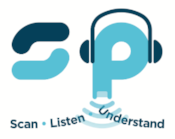What’s the Difference Between a Human Reader and a Text Reader?
We’ll start off with the obvious: although there are positives and negatives on both sides, it’s great to see anybody who needs reading support receiving it in some form or another. But support can come in many forms, and there’s no ‘one-size-fits-all’ approach to reading: what might work for one student might be a bad fit for another, and what makes one student feel supported and safe might make another feel coddled and observed. There are a couple of different roads to go down when approaching the idea, and some of the biggest differences occur when we consider the differences between in-person reading support and that done via a text reader or scanning device.
Independence
Although in-person readers can be a key element of developing confidence in readers, it can also create a pattern of reliance on them, and introduce the notion of feeling lost when they’re not there to support. Devices mean that reading largely becomes an independent act and they encourage students to work though problems by themselves when they can, and start developing their own solution patterns. Devices that support multiple functions, like having in-built dictionaries and recording functions are often an excellent choice for developing this kind of self-sufficient learning as they offer multiple ways to assist in comprehension.
Feeling Singled Out
When you’re in school, the last thing you want is to be sat in a classroom with all your peers looking at you – yet this is exactly how some students feel when receiving in-person reading support. The same might go for the workplace. People can feel singled out and even a little ostracised, and can underpin the idea that having dyslexia or literacy differences makes you different as a person, or that you need a lot of help to get through lessons. Devices are much less intrusive, and can be used quietly- shaped like a pen and supplied with a handy set of headphones, it’s often very difficult to tell if somebody is using one at all.
Covid-19 Safety
It’s an obvious one, but it’s important nonetheless: in the age of social distancing, it’s been important to stay a couple of metres apart to make sure that our schools, our workplaces and our public services are safer for everybody. The act of in-person reading support requires close-quarters working, often sitting next to students for long periods of time, which creates an environment of heightened risk for the spread of Covid-19. Devices that simply relay the text via audio feedback don’t require any additional people sat within a student’s personal space, making it easier to keep students and staff much safer.
A More Natural Pattern of Reading
Although an in-person reader is a great way to support reading development in the classroom, it doesn’t help that much when they’re not there. Dyslexia and literacy differences persist long after the school bell has rung for the end of the day, and reading is a big part of recreation too. If you’re waiting for a train or trying to unwind in the evening, it’s a great idea to settle down with a book and escape for a while, but most in-person reading support is based around the classroom and the workplace. The ability to pull out something like a ReaderPen means that reading suddenly becomes accessible from wherever you are in the world, and it’s easy to transport and travel with too.
Financial Concerns
Many businesses and educational establishments prefer to rely more on devices as opposed to human assistance as they’re much more cost-effective too. Instead of an ongoing cost – the in-person reader’s hire fee or salary – they can find an ongoing solution with a device, that often requires only one payment that’s much smaller in comparison.
Data and Privacy
When stepping into the world of work, many jobs will require some level of reading as part of their day-to-day business – this could be anything from being able to know and understand the names of complex pharmaceutical products to following written instructions, filling in forms or even just tackling a pile of invoices. Even though in-person readers are supported under the UK’s Access to Work Grant and a number of statewide access programmes in the US, many employers prefer to use devices as opposed to in-person support as it offers them a much higher level of data privacy. Although some devices do offer a save function, there are options that don’t, such as the ReaderPen Secure, which means that only the employee using the pen can be privy to the scanned material it’s relaying.
Reading support is a very personal thing, and as well as supporting learning, it’s key in developing confidence as a learner at every level of the school system and beyond. Finding what fits might take some time, or it might simply be a case of introducing a new element to the process – what’s important is that making sure that everyone can approach the act of reading confident in their own abilities and ready to learn, work, and even have fun too.
